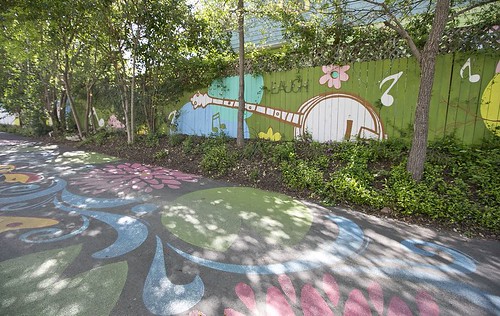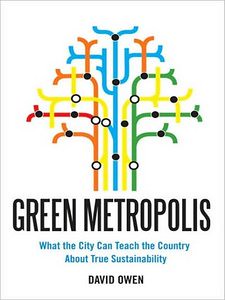Alleys and parklets and water and sustainability

Fairy Alley, Austin Neighobrhood Partnership Program. The street is painted with sparkly designs and the fence has a mural at Fairy Alley on Thursday, March 26, 2015. The project was completed as part of the city's neighborhood partnering program. DEBORAH CANNON / AMERICAN-STATESMAN
Alleys. San Francisco has released a Living Alleys Toolkit document, in support of their alley improvement program in the Market Octavia neighborhood. A section of the report lists/provides links to similar programs across the US, such as An Action Guide to Greening Austin’s Alleys [no longer available online, a useful list, not out of this world], produced by the Public Interest Design Studio at the University of Texas Austin, Texas.
The Austin guide lists 17 tools:
1. Permeable Pavement
2. Lighting
3. Rain Gardens and Bioswales
4. Native Landscaping
5. Alley Gateway
6. Street Graphics
7. Edge Treatments
8. Garbage Bin Corral
9. Rain Barrel
10. Address Marker
11. Compost Bin
12. Alley Furniture
13. Shading
14. Traffic Calming
15. Edible Alleys
16. Closed Alleys
17. Alley Flats
It also provides information on the Alley Network Project in Seattle's Pioneer Square neighborhood. They have a bunch of great resources including, "alley designs" featuring the Pioneer Square Alley Design Manual and Pioneer Square Alley Lighting Guidance .
To be honest, while the projects are cool, most aren't fully applicable to DC, since most of DC's alleys are used for trash collection, which requires unimpeded throughway for heavy vehicles.
On the other hand, trash could be "walked out" to the street, which could allow for alternative treatments in alleys.
Parklets. In Philadelphia, the University City Business Improvement District (sponsor of The Porch project at 30th Street Station), did a study of parklet projects, The Case for Parklets: Measuring the Impact on Sidewalk Vitality and Neighborhood Businesses, which challenges the conventional wisdom that parking is the most important element of commercial districts, supporting the patronage of neighborhood businesses.
 DC Water Authority. DC Water (DC Water and Sewer Authority) is doing a series of town meetings, on a ward by ward basis. ANC Commissioner Kent Boese wrote a blog entry ("Brief Notes from the DC Water Ward 1 Town Hall Meeting").
DC Water Authority. DC Water (DC Water and Sewer Authority) is doing a series of town meetings, on a ward by ward basis. ANC Commissioner Kent Boese wrote a blog entry ("Brief Notes from the DC Water Ward 1 Town Hall Meeting").Mandated by the Federal Clean Water Act, mostly rates will go up to pay the $2.6 billion cost to build a system to fully capture stormwater without it being combined with sewage and discharging it into the area rivers without treatment during major storm events.
Interestingly, they are proposing a "lifeline rate," of a lower charge for the first 4 hundred cubic feet of water consumed each month (each "ccf" is 748 gallons), almost like the "homestead" tax reduction for owner occupied houses. That would save people not quite $1/month.
Also see "Saving US Water and Sewer Systems Would Be Costly," New York Times.
Sustainability in Los Angeles (and elsewhere). The Associated Press has a story, "LA Mayor Envisions Greener, More Walkable City in the Future," on Los Angeles' new sustainability plan. DC now faces more competition to be the "most sustainable American city" within 20 years. From the article:
Among LA's short-term goals: Install 1,000 new charging stations for electric vehicles; clean up contaminated groundwater in the San Fernando Valley and create more green jobs.
In the coming decades, the city wants to achieve zero waste, replace its municipal fleet with electric vehicles, expand the use of recycled water and help residents cut down on car trips.
Some of the goals were previously announced, including the call for a 20-percent reduction in the city's per-person use of fresh water by 2017 to deal with the drought.One quote in the article irks me:
"For years, living sustainably in the urban environment has been given more lip service than action," Joel Reynolds of the Natural Resources Defense Council said in a statement.
 The reality is that even without special programs and accommodations, denser living in the urban core, especially in transit cities, is far more environmentally sustainable than suburban or exurban living, as David Owen makes the case in the book, Green Metropolis.
The reality is that even without special programs and accommodations, denser living in the urban core, especially in transit cities, is far more environmentally sustainable than suburban or exurban living, as David Owen makes the case in the book, Green Metropolis.Residents in dense cities, especially in New York City, use less space per capita, and consume less energy and less gasoline, and produce less waste per capita.
Sure goods and services are trucked in, but this is the same case for suburban residents.
Labels: alleys, green-environment-urban, infrastructure, parks, sustainable land use and resource planning, urban design/placemaking, water supply and use



10 Comments:
as an owner in two separate historic alleys in DC I can tell you that garbage is a huge problem- especially garbage generated by street fronting people and those who use alleys as a dumping ground. It is a constant struggle to keep equillibrium and sanity. Some street fronting people have a over inflated sense of propriety and self worth- a sense of entitlement that goes beyond rationality. Many of these people are older and car centric people who view alley residents a young, poorer, or just worthless human beings that get in the way of their parking , garages, free disposal of trash, or slow them down while parking with attempts to beauify the alleys [ they often complain about planters and other objects used to alliviate the doldrums]
they wouldn't like the SF project...
in terms of DC water talk about perverse incentives.
Rates are going up because of stormwater, but you'll charge homeowners (Not multi-unit) less if they use less water??
Talk about hidden subsidies.
I think that in the Barry era, churches used to get free water. (A one-time friend bought a house from a church, and for many years, she never got a water bill. But I remember other instances besides that. I think the Control Board brought an end to that practice.)
You're right that by not offering the special rate, it is unfair to multiunit households. However, I expect that individual units aren't metered for water in m/any multiunit buildings and complexes. What's the deal in your building?
... although, in NYC, buildings didn't use to have individual water meters per unit, and they had massive water waste. Once the city forced individual metering, usage dropped considerably.
and wrt your general point, you're right that as costs to maintain and repair water and sewer infrastructure come due irrespective of new requirements as a result of federal regulations--in most cities the infrastructure is pretty old--reduction in water use does reduce revenue.
This is a particular problem in Europe. I think I cited a WSJ article on this before.
http://www.wsj.com/articles/theres-too-much-water-in-germany-but-that-wont-stop-people-from-sharing-bath-water-1411957801
Yep -- water is not metered. Multiunit pay a lot more into the system b/c of the impervious service charge. The water bill here (26 units) is very painful.
I'd guess my building is about the length of 4 or 5 rowhouses, but paying a lot more than 5x.
I'm not sure waste is a real issue. Broken toilets etc can be -- you can easily wring up a few hundred in water bills if it isn't fixed promptly.
my brother tells the story about a friend of his living in the Bronx probably, who would flush the toilet after every turd... he changed that behavior once they started having to pay their water bill directly.
dk about your building, but I was reading a piece about Walmart and how on some of their buildings, they're capturing rainwater to water plants in the garden center. The Home Depot shopping center on Rhode Island Ave. could do something like that...
and I haven't written yet about the Austin Neighborhood Partnership Program. One of the things they did at one community garden is support the installation of a very large rain barrel system to use for watering plants.
I could see creation of "district gray water capture systems" for reuse of water in sub-areas of the city.
I haven't looked at it recently, but Chicago had a "green" alley program and it seemed to me to be broadly applicable to DC.
Green Metropolis is an excellent book and something lik eit should have come out a long time ago- it really shames so many of the 1960's hippy counter culture people in the USA who eschewed cities and towns for rural, car-dependent places and how in their quest for all things "green" overlooked a huge problem that is at the absolute nexus of environmental concerns- that cars are a major- if the number one- environmental problem. It astonishes me how many people who get all upset about climate change are completely unwilling to see their own suburban car dependent behaviors as complicit in the problems we face- the very people that complain th emost seem to be the WORST of offenders IMO. These people are completely blind to what they do personally- they cannot see the forest for the trees.My only critique of the book is that it does not see DC as a city that is on the cutting edge of change when we really are part of it. This is typical of people who are not from here- they do examine us in the kind of detail that results in fair reporting...
do NOT examine us in the kind of detail....
https://austintexas.gov/sites/default/files/files/Alleys_as_Community_Resources_White_Paper_-_FORMATTED.pdf
Post a Comment
<< Home